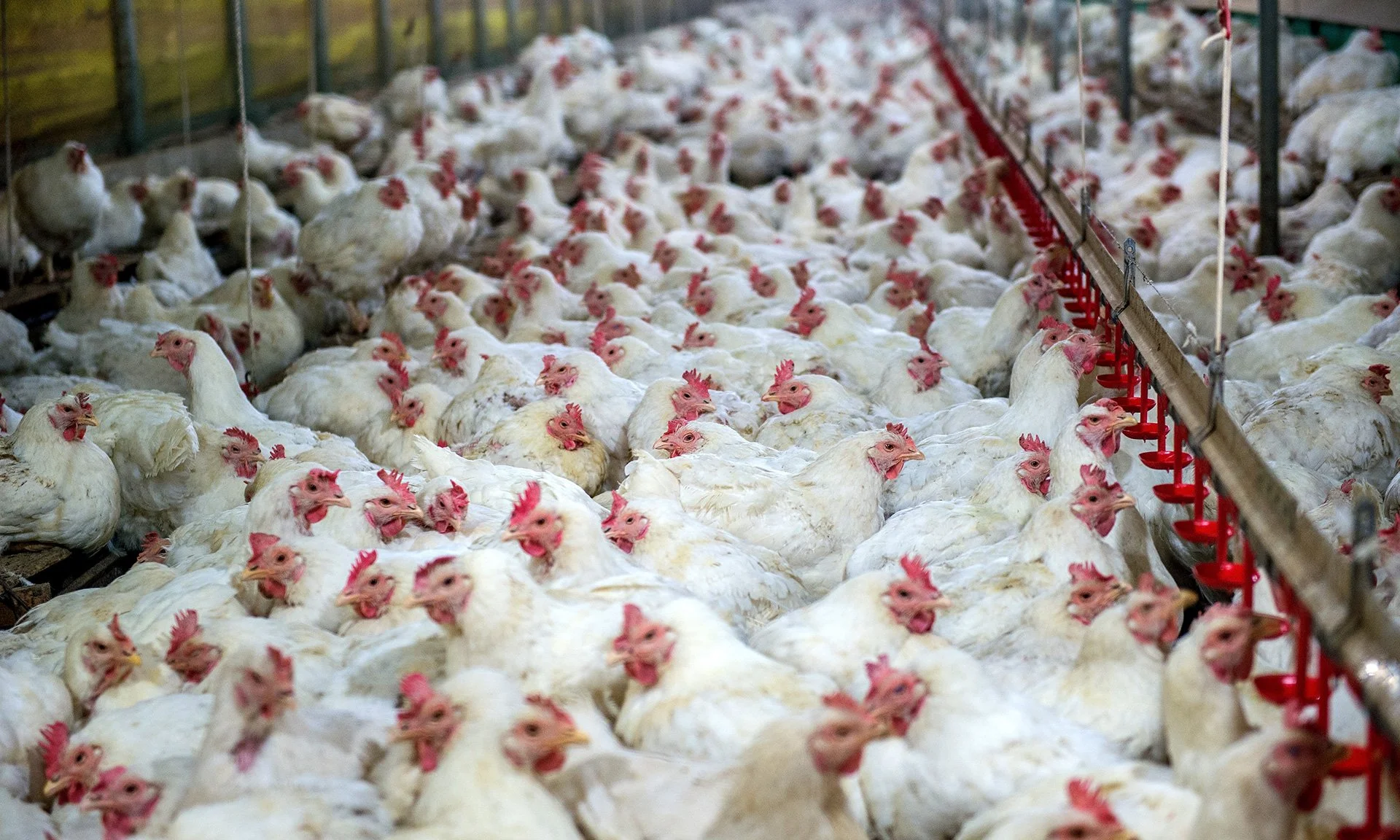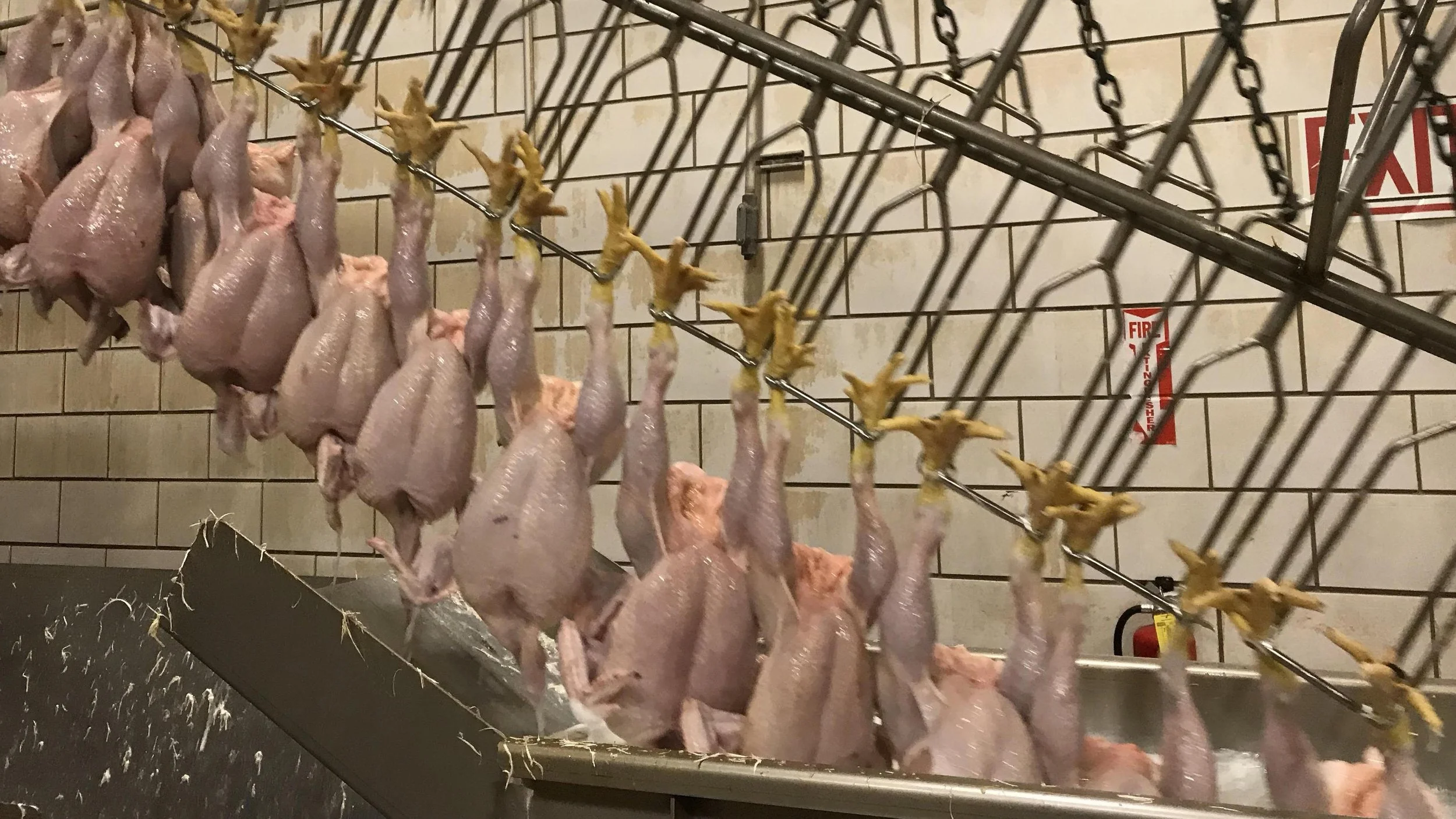Electrocution - Fecal Baths - Bleach
Industrial foods might be cheap, but it comes at a cost to the animal, your health, and your future.
At Foundry Farms, we do things differently.
(Scroll to the bottom for the Foundry Way)
What’s Really Going On With Industrial Chicken?
Most people don’t know how their chicken is raised, processed, or handled before it reaches the store. The truth is unsettling. Industrial poultry production prioritizes speed and profit over animal welfare, food quality, and your health. From chemical washes and cramped living conditions to inhumane slaughter methods and misleading labels, the problems run deep.
At Foundry Farms, we believe you deserve to know the truth—and make informed choices. Tap on any topic to learn what the commercial poultry industry doesn’t want you to see. You will probably never eat the same again.
-
In most industrial plants, chickens are shackled by their feet and hung upside down while fully conscious. Their heads are dragged through an electrified water bath intended to render them unconscious before slaughter. But if the settings aren’t perfect—and they often aren’t—some birds are under-stunned and remain aware and in pain as their throats are slit. Others are over-stunned, which causes cardiac arrest before bleeding, resulting in poor bleed-out and blood retention in the meat. It’s a stressful, imprecise, and often inhumane method.
Some industrial producers have turned to carbon dioxide (CO₂) or argon gas stunning as a supposedly more humane method. In these systems, birds are placed in chambers where oxygen is replaced with high concentrations of gas, which puts the birds to sleep before slaughter. However, CO₂ can cause intense respiratory distress before unconsciousness—similar to suffocation. Birds may flap, gasp, and panic in the final moments. And while gas stunning avoids physical injuries from shackling, it still fails to address the core problem: animals are treated as units on a line, not as living beings.
-
In industrial poultry plants, it’s common practice to wash chicken carcasses in chlorine baths or antimicrobial solutions like peracetic acid. Why? Because during fast-paced processing, fecal matter and bacteria often end up on the meat. Rather than preventing contamination in the first place, the industry relies on chemicals to “sanitize” the product. In some cases, a chicken can go through up to 40 chemical baths. While these solutions reduce bacterial counts, many people are uncomfortable with the idea of chemically treated meat—especially when the contamination could be avoided with cleaner, slower, more humane processing methods.
-
Because of the sheer speed of industrial processing lines—often up to 175 birds per minute—there’s a high likelihood that intestines are ruptured during gutting. This spills feces onto the meat, which can spread bacteria like Salmonella and E. coli. USDA inspectors are only allowed to reject visibly contaminated carcasses, meaning many still make it through the line. Bleaching doesn’t fully solve the problem—it just masks it.
-
Birds raised in cramped, unsanitary spaces are more prone to disease, so they’re routinely given antibiotics—not just to treat illness, but to prevent it. This constant exposure leads to antibiotic-resistant strains of bacteria that can be passed on to humans through meat. The CDC and WHO have both warned about the public health risk. At Foundry Farms, we never use antibiotics because our chickens are raised in clean, open-air environments where disease is far less likely to take hold.
-
In large-scale facilities, tens of thousands of chickens are crammed together in windowless barns with little to no space to move. They live on top of their own waste, breathe ammonia-rich air, and suffer from stress and injury. These birds never see the sun or scratch at the soil like chickens are meant to. Their quality of life is minimal, and their environment increases the likelihood of sickness and poor meat quality.
-
Industrial chicken is typically chilled in massive vats of cold water after processing. This is known as immersion chilling. The problem? The chicken absorbs water—sometimes up to 12% of its total weight. That’s water you pay for at the store. It also dilutes flavor and increases the risk of cross-contamination, since multiple carcasses are chilled in the same tank. Often times this tank has a foot of fecal matter in it, so that’s what soaks into your meat.
-
After slaughter, a chicken should ideally bleed out as completely as possible. But in many industrial settings, the combination of high-speed processing and improper stunning results in poor blood drainage. If the heart stops too early—due to over-stunning or trauma—the body doesn’t pump out its blood. This leaves residual blood in the wings, breast, and thighs, affecting shelf life, taste, and cleanliness. At Foundry Farms, our kill-cone method allows gravity and the still-beating heart to do their job, producing a cleaner, more flavorful bird.
-
Shackling live birds by their feet and sending them down a moving rail causes trauma. They flap, panic, and often suffer dislocated joints, bruises, and even broken wings. This affects both the welfare of the animal and the quality of the meat. You’ve probably seen bruised chicken in the grocery store before—it’s not uncommon. Our birds are never shackled. They are gently handled and processed in small batches with care and respect.Item description
-
Industrial chickens are bred to grow incredibly fast—reaching full processing weight in just 5 to 6 weeks. While this is efficient for producers, it comes at a cost. These birds often suffer from leg deformities, heart failure, and joint pain. Their bodies grow faster than their organs or bones can support. At Foundry Farms, our chickens grow at a natural pace, resulting in healthier animals and more nutritious meat.
-
The poultry industry uses labels like “all-natural,” “cage-free,” or “hormone-free” to create a false sense of health and ethics. But all poultry in the U.S. is hormone-free by law. “Cage-free” usually refers to egg-laying hens—not meat birds—and it doesn’t mean they had access to pasture. It means they had access to at least two square feet of pasture that they may never touch. “All-natural” means nothing more than minimally processed. At Foundry Farms, we don’t rely on gimmicks. We simply raise real chickens the right way—on pasture, without chemicals, antibiotics, or confusion.
The Foundry Way
At Foundry Farms, we believe raising chickens isn’t just about producing meat—it’s about stewarding life, respecting creation, and feeding our community with integrity. Here’s how we raise and process our chickens the right way:
-
Our chickens live outside on fresh pasture—free to roam, scratch, peck, dust bathe, and enjoy the sunshine. They’re moved regularly to fresh grass, which not only improves their health but regenerates the soil. No concrete floors. No overcrowded barns. Just real birds living a real life.
-
Because our birds are raised in clean, low-stress environments with constant access to sunshine and fresh air, they stay naturally healthy—without the need for antibiotics or growth enhancers. We let them grow at their natural pace, resulting in healthier meat and healthier people.
-
Industrial chicken is often dunked in chlorine to cover up contamination. We never use chemical washes. Our chickens are processed cleanly, slowly, and carefully—meaning there’s no need for shortcuts or coverups.
-
We use the kill cone method, which keeps the birds calm and still. A quick, precise cut allows for a full bleed-out while the bird is gently restrained. This process is quiet, controlled, and significantly more humane than industrial stunning methods. The result? Less stress for the animal, cleaner meat, and a more respectful process.
-
With gravity and a still-beating heart, our birds bleed out completely, unlike industrial birds stunned into cardiac arrest. This leads to cleaner, tastier meat with better shelf life and less residual blood in the tissues.
-
We process our birds in small numbers, ensuring that every step is done with attention and care. There are no high-speed conveyor belts, no careless mistakes—just slow, responsible handling from start to finish.
-
From the day they hatch to the day they’re harvested, our chickens are treated with the dignity they deserve. We believe farming is a calling—and we strive to honor the animals and the families we serve with every decision we make.










